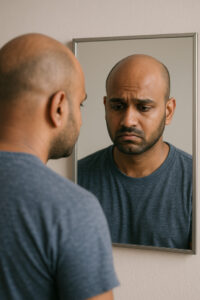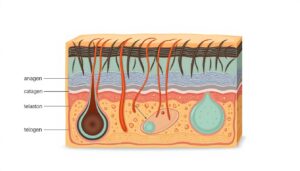Understanding the intricacies of hair growth is a concern for many, particularly when it comes to knowing the age limit for hair growth among Indian men and women. The hair growth cycle is influenced by a multitude of factors including genetics, nutrition, and overall health.
The hair growth cycle consists of three phases: anagen, catagen, and telogen. The duration of these phases varies from person to person, and is affected by factors such as hormonal changes, diet, and lifestyle.
Key Takeaways
- The hair growth cycle has three distinct phases.
- Genetics play a significant role in determining hair growth.
- Nutrition and overall health impact hair growth.
- Hormonal changes can affect the hair growth cycle.
- Lifestyle factors influence hair growth.
Understanding the Hair Growth Cycle
To comprehend hair growth, it’s essential to delve into its cyclical nature. The hair growth cycle is a complex process that is divided into distinct phases, each playing a crucial role in determining the length and health of hair.
The Four Phases of Hair Growth
The hair growth cycle consists of four phases: Anagen, Catagen, Telogen, and Exogen. The Anagen phase, also known as the growth phase, can last anywhere from 2 to 6 years, during which the hair grows actively. The Catagen phase is a short transitional phase lasting about 2-3 weeks, where hair growth stops. The Telogen phase, or resting phase, lasts about 3-4 months, after which the hair enters the Exogen phase, where it sheds.
Average Hair Growth Rates
On average, hair grows about 0.3 to 0.4 millimeters per day, or about 1/2 inch (1.3 cm) per month. This translates to approximately 6 inches (15 cm) per year. However, hair growth rates can vary significantly among individuals due to factors such as genetics, nutrition, and overall health.
| Phase | Duration | Description |
|---|---|---|
| Anagen | 2-6 years | Active hair growth phase |
| Catagen | 2-3 weeks | Transitional phase where growth stops |
| Telogen | 3-4 months | Resting phase |
| Exogen | Varies | Hair shedding phase |
Hair Growth Age Limit in Indian Men and Women
Indian men and women often wonder about the age limit for hair growth, a question that is both complex and multifaceted. Hair growth is influenced by a variety of factors including genetics, diet, and overall health. Understanding the general timeline for hair growth and when it typically slows down can provide valuable insights into maintaining healthy hair.
General Timeline for Hair Growth
Hair growth occurs in three phases: anagen, catagen, and telogen. The anagen phase, also known as the growth phase, can last anywhere from 2 to 6 years, during which hair grows rapidly. The length of this phase determines the maximum length of hair. On average, hair grows about 0.3 to 0.4 mm per day, or about 1/2 inch (1.3 cm) per month.
The average hair growth rate can vary among individuals due to factors such as age, genetics, and overall health. For instance, hair growth tends to be faster in younger individuals and slower in older adults. Nutritional deficiencies and certain health conditions can also impact hair growth rates.
When Hair Growth Typically Slows Down
Hair growth typically slows down with age, particularly after the age of 40. As people enter their 50s and beyond, the growth rate can decrease significantly due to the natural aging process. Additionally, hormonal changes, stress, and certain medical conditions can contribute to slower hair growth.
- Genetic predisposition plays a significant role in determining hair growth patterns.
- Diet and nutrition are crucial for maintaining healthy hair growth.
- Lifestyle factors, including stress levels and hair care practices, can also impact hair growth.
By understanding these factors and maintaining a healthy lifestyle, individuals can promote optimal hair growth throughout their lives.
Genetic Factors Affecting Hair Growth in Indians
Understanding the genetic factors that affect hair growth can provide valuable insights into the hair growth patterns observed in Indians. Genetics play a pivotal role in determining not just the growth rate, but also the texture, thickness, and longevity of hair.
Common Genetic Traits in Indian Hair
Indian hair is known for its diversity, reflecting the country’s genetic heterogeneity. Common traits include a wide range of textures from straight to curly and various shades of black to blonde. Genetic predispositions influence whether an individual has thick, thin, straight, or curly hair.
Hereditary Patterns of Hair Growth
Hereditary patterns significantly influence hair growth. If parents have a history of healthy, robust hair, their offspring are likely to inherit these traits. Conversely, hereditary hair loss or thinning can also be passed down through generations. Understanding these patterns can help in predicting and managing hair growth.
Ethnic Variations Within Indian Populations
India is a melting pot of various ethnic groups, each with distinct genetic characteristics that influence hair growth. For instance, individuals from the southern part of India may have different hair textures compared to those from the northern regions. These ethnic variations contribute to the diverse hair growth patterns observed across the country.
| Ethnic Group | Common Hair Texture | Average Hair Growth Rate |
|---|---|---|
| South Indian | Thick, Straight | 0.5 cm/month |
| North Indian | Medium, Wavy | 0.4 cm/month |
| Northeast Indian | Curly, Fine | 0.45 cm/month |
By understanding these genetic factors and ethnic variations, individuals can better appreciate their hair’s unique characteristics and adopt appropriate hair care practices.
Age-Related Hair Growth Patterns in Indian Men
Understanding age-related hair growth patterns is essential for Indian men seeking to maintain healthy hair. Hair growth is a dynamic process that changes over time, influenced by a combination of genetic, hormonal, and environmental factors.
Teenage to Early Adulthood (20s)
During the teenage years and early adulthood, Indian men typically experience peak hair growth due to high levels of testosterone. This period is characterized by dense and thick hair. However, some men may start experiencing hair loss due to genetic predispositions or other factors.
- Hormonal changes drive hair growth.
- Genetic predispositions can lead to early hair loss.
- A healthy diet supports optimal hair growth.
Middle Age (30s-40s)
As Indian men enter their 30s and 40s, hair growth rates may start to slow down. Hormonal changes, stress, and lifestyle factors can contribute to hair thinning and loss. Maintaining a balanced diet and managing stress become crucial during this phase.
Key factors influencing hair growth during this stage include:
- Increasing stress levels.
- Changes in dietary habits.
- Hormonal imbalances.
Later Years (50s and Beyond)
In their 50s and beyond, Indian men often experience a significant reduction in hair growth due to aging. The hair that grows may be thinner and less dense. While some hair loss is natural, certain hair care practices and medical treatments can help manage the condition.
“Aging is inevitable, but with the right hair care, men can maintain healthy hair even in their later years.”

By understanding these age-related hair growth patterns, Indian men can take proactive steps to promote healthy hair growth throughout their lives.
Age-Related Hair Growth Patterns in Indian Women
As Indian women progress through different life stages, their hair growth patterns evolve. This evolution is influenced by a combination of hormonal changes, genetic factors, and lifestyle influences.
Teenage to Early Adulthood (20s)
During the teenage years and early adulthood, Indian women’s hair growth is typically at its peak due to high levels of estrogen and a robust metabolism. Hair tends to be thicker and fuller, with a faster growth rate. However, factors such as stress, dietary habits, and hair care practices can affect hair health.
Middle Age (30s-40s)
In their 30s and 40s, Indian women may start to notice changes in their hair growth patterns. Hormonal fluctuations, particularly during pregnancy and menopause, can lead to variations in hair density and growth rate. Additionally, increased stress and potential nutritional deficiencies can impact hair health.
Later Years (50s and Beyond)
As women enter their 50s and beyond, the decrease in estrogen levels during menopause can lead to thinner, shorter hair with a slower growth rate. Understanding these changes and adopting appropriate hair care strategies can help manage age-related hair growth changes.
By recognizing the age-related hair growth patterns, Indian women can take proactive steps to maintain healthy and vibrant hair throughout their lives.
Environmental and Lifestyle Factors Affecting Indian Hair Growth
Environmental and lifestyle factors play a crucial role in determining hair growth patterns in Indian men and women. These external factors can either promote healthy hair growth or contribute to hair loss and other scalp issues.
Diet and Nutrition Impact
A well-balanced diet rich in vitamins and minerals is essential for healthy hair growth. In India, where diverse diets are prevalent, nutritional deficiencies can impact hair health. Foods high in protein, iron, and omega-3 fatty acids, such as nuts, leafy greens, and fish, are particularly beneficial.
Nutritional Elements that support hair growth include:
- Protein: Essential for hair structure
- Iron: Crucial for hair follicle health
- Omega-3 Fatty Acids: Promotes scalp health
Climate and Pollution Effects
India’s diverse climate, ranging from humid to dry conditions, affects hair growth. High humidity can lead to frizz and hair damage, while dry climates can cause dryness and breakage. Additionally, pollution in urban areas can damage hair follicles and slow growth.
| Climate Condition | Effect on Hair |
|---|---|
| High Humidity | Frizz, Damage |
| Dry Climate | Dryness, Breakage |
| Pollution | Damage to Hair Follicles |
Stress and Lifestyle Habits
Stress and lifestyle habits, including smoking and excessive heat styling, can negatively impact hair growth. Stress can lead to hair loss conditions like alopecia areata, while excessive heat styling can damage the hair shaft.
Traditional and Modern Hair Care Practices in India
From ancient Ayurvedic methods to modern scientific approaches, India’s hair care practices are a fascinating mix of tradition and innovation. Indian hair care has been influenced by a rich cultural heritage, with various practices being passed down through generations.
Ayurvedic Hair Care Methods
Ayurvedic hair care is deeply rooted in Indian tradition. It emphasizes the use of natural ingredients like amla, neem, and brahmi to promote hair health. These ingredients are known for their nourishing properties and are often used in various hair care formulations.
“Ayurveda is not just a system of medicine; it’s a way of life that encompasses holistic well-being, including hair care,” as emphasized by practitioners. The use of Ayurvedic herbs and practices is a testament to India’s rich cultural heritage in hair care.
Oil Treatments and Massage Techniques
Oil treatments and massage are integral parts of Indian hair care. Techniques like Abhyanga, which involves massaging oil into the scalp, are believed to stimulate hair growth and improve scalp health. Popular oils used include coconut, olive, and almond oil, each chosen for their unique nourishing properties.
The practice of massaging oil into the scalp not only promotes hair growth but also helps in reducing stress, thereby contributing to overall well-being.
Integration of Modern Hair Care Science
In recent years, there has been a significant integration of modern hair care science with traditional practices in India. This blend is evident in the development of products that combine natural ingredients with scientifically proven formulations. Modern hair care science has helped in understanding the benefits of traditional practices and enhancing them with advanced research.
The result is a comprehensive approach to hair care that leverages the best of both worlds, offering effective solutions for various hair-related concerns.
Common Hair Growth Myths and Facts for Indians
There’s a significant gap between perceived hair growth facts and actual science-backed truths in India. Hair care practices are often influenced by myths and misconceptions that can hinder effective hair growth.
Debunking Popular Misconceptions
Many believe that frequent hair cutting promotes faster growth. However, hair growth is determined by the scalp, not the length of the hair. Another myth is that hair growth can be significantly enhanced by applying certain oils or serums. While these products can improve hair health, their impact on growth rate is often exaggerated.
Some people also believe that stress directly causes hair loss. While stress can contribute to hair loss, it’s not the sole cause. Genetics, hormonal changes, and nutritional deficiencies play a more significant role.
Science-Backed Facts About Indian Hair Growth
Research indicates that the average hair growth rate for Indians is about 0.4 to 1.3 cm per month. Factors such as diet, genetics, and overall health significantly influence hair growth.
A balanced diet rich in vitamins and minerals, particularly those that promote hair health like biotin and vitamin E, can support hair growth. Regular scalp massages and reducing stress through practices like yoga can also be beneficial.
| Myth/Fact | Description |
|---|---|
| Myth: Frequent hair cutting promotes faster growth | Hair growth is determined by the scalp, not hair length |
| Fact: Diet influences hair growth | A balanced diet rich in vitamins and minerals supports hair health |
| Myth: Stress is the sole cause of hair loss | Genetics, hormonal changes, and nutritional deficiencies also play a role |

Conclusion
Understanding hair growth is crucial for maintaining healthy and robust hair. In Indian men and women, hair growth is influenced by a combination of genetic, environmental, and lifestyle factors.
A hair growth summary reveals that the average growth rate is about 0.4 to 0.5 mm per day, or roughly 1/2 inch (1.3 cm) per month. The hair growth cycle consists of four phases: anagen, catagen, telogen, and exogen. Indian hair growth patterns vary across different age groups and are affected by factors such as diet, climate, and stress levels.
Reaching an Indian hair growth conclusion, it’s clear that a balanced diet rich in nutrients, minimal stress, and proper hair care practices can promote healthy hair growth. Ayurvedic methods, oil treatments, and massage techniques are some traditional practices that have been used to enhance hair growth.
By understanding the factors that influence hair growth and adopting a holistic approach to hair care, Indians can maintain healthy and vibrant hair throughout their lives.





